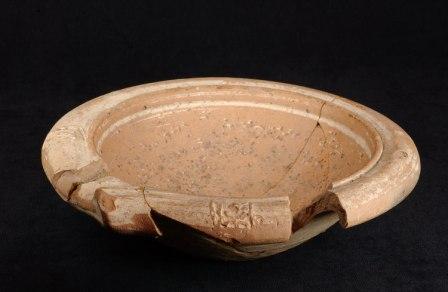There are many ways to assess past landscapes from the view point of food production. One of the ways is indirect, looking at the vessels used in transporting, storing and circulating food stuffs. The Romans were not the first to move food long distances but their trade routes served all areas around the Mediterranean and provided the city of Rome with grain and other produce that kept the population of this first mega-city alive. One needed only to view the new miniseries of Mary Beard, Meet the Romans and see her sitting near the top of Monte Testaccio, the artificial mound of amphora sherds still standing south from the old centre of the city of Rome. This hill is a tangible evidence of the huge quantities of food that reached the river port of Rome. Due to a discussion I had last week in the coffee room I look at mortaria, a type of large bowl the Romans used widely and which are found in large quantities.
In May I am heading to a mortarium workshop in order to learn how to record and study this type of vessel. The wide distribution of mortaria in Britain contrasts with the few sherds we had from the Nepi survey. Another example of an Italian site with an incidence of an occurance of mortarium is Cetamura del Chianti (Hargis 2007). Even if mortaria were produced in the Mediterranean – most notably along the Syrian coast in the Middle East (see Heyes 1967) – they are relatively scarce in many areas. This either means that they were not needed or that something else was used as a replacement.
Mortaria as a vessel type represents a continuum from Etruscan and other earlier grinding vessels and pestles (see e.g. Hargis 2007 for the full story). They were being produced in Italy by the Roman brick yards and exported across the Roman Empire. They have been found in about ten shipwrecks as cargo, most commonly along the coast of Spain and France (based on Parker 1990). Many Roman mortaria bear stamps and thus much of the study of Roman mortaria has focused on the evidence they give instead of discussing the general vessel form. By the second century AD, mortaria production centred outside Italy. Apart from the important workshops in Syria mortaria were made also in Gaul but they were the most widespread in Britain.
Lucy Cramp from the University of Bristol studied mortaria and their food residues in her PhD. She extracted and analyzed absorbed and surface residues from c. 600 Roman pot sherds via HTGC, GC/MS and GC-C-IRMS in order to reconstruct and compare culinary patterns. She found out that it was possible to distinguish different vessel groups based upon the organic residue data that showed that these vessels were used differently in antiquity. Her research also indicated continuity of food processing and consuption from the Iron Age into the Roman period despite the use of ‘Roman’ style material culture.
The analysis of GC-MS chromatograms of lipid extraction from mortarium samples and cooking vessels from Roman Britain was carried out by a research group Lucy Cramp made part of the discovery that even if the mortaria was introduced by the Romans they were used in Britain not to grind foodstuff for pounding and mixing commodities to make highly flavoured Roman sauces, rissoles and stews. Alternative, use as a dairying vessel has also been suggested. The rapid adoption of the vessel type at more rural and unromanised sites as well as more romanised urban and military sites has been explained to demonstrate the extent and speed of the transition from native to romanised diet. The samples included material from sites as varied as Fishbourne and Wroxeter and had comparative samples from Xanten in ancient Germania Inferior. Recently published results suggest that it was not the diet that changed. The British just applied a new method of preparing certain products. Plants were being ground in the vessels as well as cooked in the pot. These vessels also contained animal fats, including dairy products.
These results suggest that the distribution and use of mortaria in ancient Roman empire reflect different cultures of food making. In this way the distribution of ceramics reveals us the past landscapes of food production (c.f. ceramiscene in my earlier blog).
References
Hargis, M. 2007. A mortarium at Cetamura del Chianti in context at the Florida State University.Hayes, J. W. 1967. North Syrian Mortaria. Hesperia 36, 337-347.
Parker, A. J. 1990. Ancient shipwrecks of the Mediterranean and the Roman Provinces. BAR International series 580.




No comments:
Post a Comment